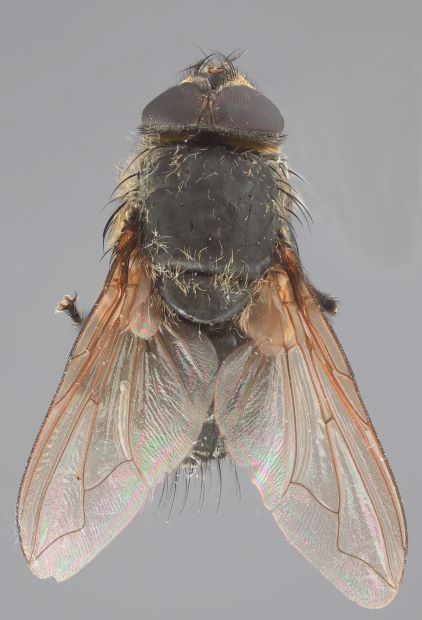Cluster Flies (Pollenia spp.)
Cluster flies can be a nuisance around and inside buildings in the fall.
Damage/Behavior:
Cluster flies are dark gray in color, slow moving, and larger than a house fly (1/3 inch (8 mm)) (Fig. 1). There can be hundreds of flies aggregating on the sunny sides of buildings in late fall and entering through attics and higher areas of a structure to overwinter. Some will emerge into the interior a few at a time during winter. Large aggregations of cluster flies emerging from hibernation will often go to the nearest light source, such as a window or glass door and tend to die rather quickly. They can attempt to exit all at once and can be a serious nuisance. Unlike most flies, they do not breed in decaying organic matter. Rather, the immatures are parasites of earthworms.

Figure 1: Cluster fly. Photo by L. Kerzicnik
Management:
Non-Chemical Controls
- Vacuum up all the adults that you see. Even though they aren’t reproducing in the home, this will cut down on future populations for the adult flies that do survive the winter within the home.
- Also, pay attention to the south and west sides of the building on the outside. Caulk and seal up any areas that you might see that have gaps.
Chemical Controls
- Target the chemical controls for late summer/early fall.
- Pyrethroids (class of pesticides) are a good choice for a barrier/perimeter application. They can leave a residue for 2-3 weeks on the outside of the house. Their chemical names usually end in “-thrin,” such as bifenthrin, cyfluthrin, cypermethrin, deltamethrin, lambda-cyhalothrin, and permethrin. Some example products include Tempo or Ortho Home Defense. Several other products are available. Make sure to use an insecticide that is labeled for use on exterior buildings. Please follow the label for whatever product you might use.
- Apply materials to a two- to six-foot wide band along the soil around the foundation and two to three feet up the foundation walls. Target areas where insects are aggregating, such as south- and southwest-facing areas. The band of insecticide should be as continuous as possible and should include the areas around windows, doors, and other possible entrances as per label directions.
- Bug bombs are not effective for cluster fly control and are not recommended.
Disclaimer: These recommendations are provided only as a guide. It is always the pesticide applicator’s responsibility, bylaw, to read and follow all current label directions for the specific pesticide being used. The authors and Montana StateUniversity assume no liability resulting from the use of these recommendations. The Montana State University Extension Service is an ADA/EO/AA/Veteran’s Preference Employer and Provider of Educational Outreach.
